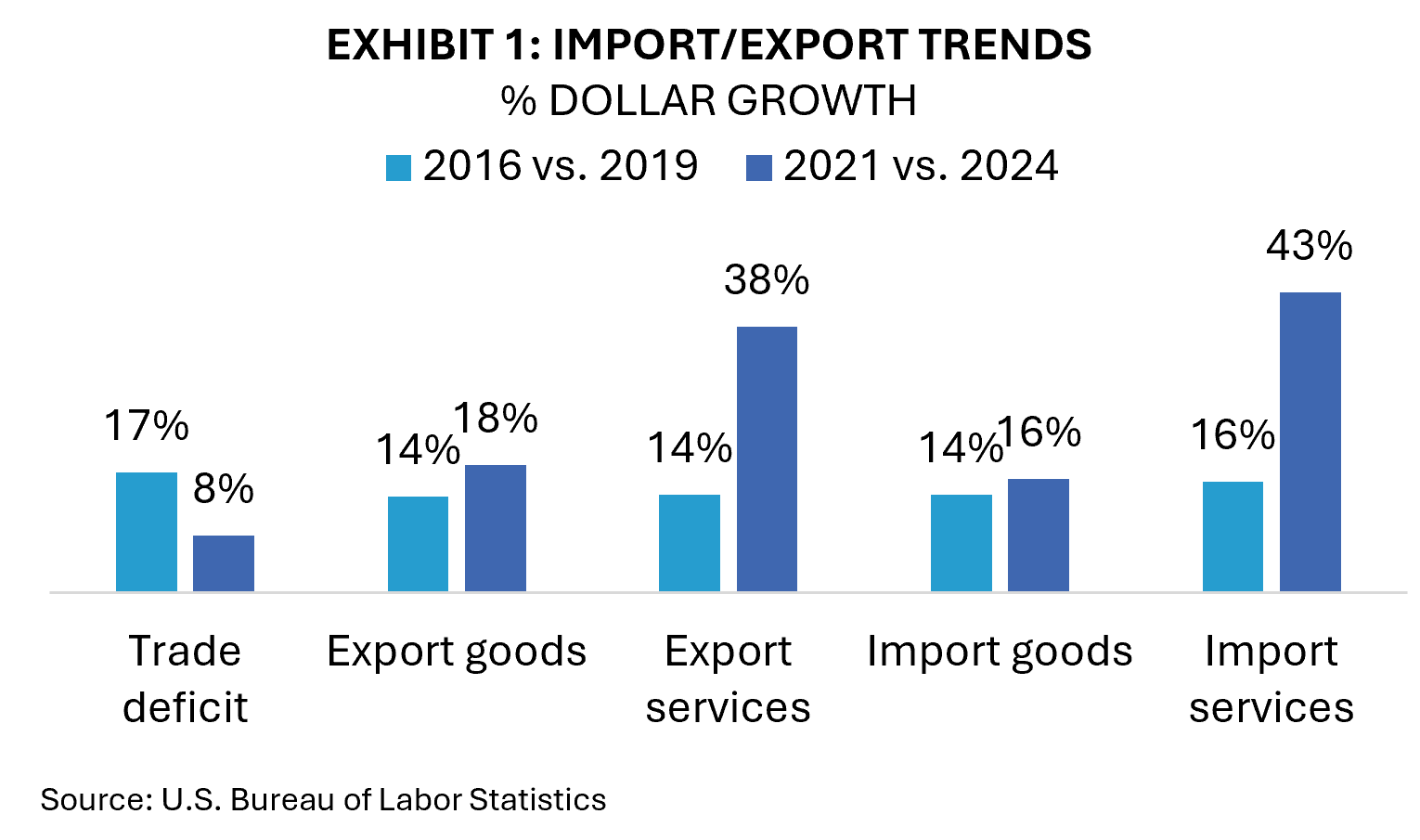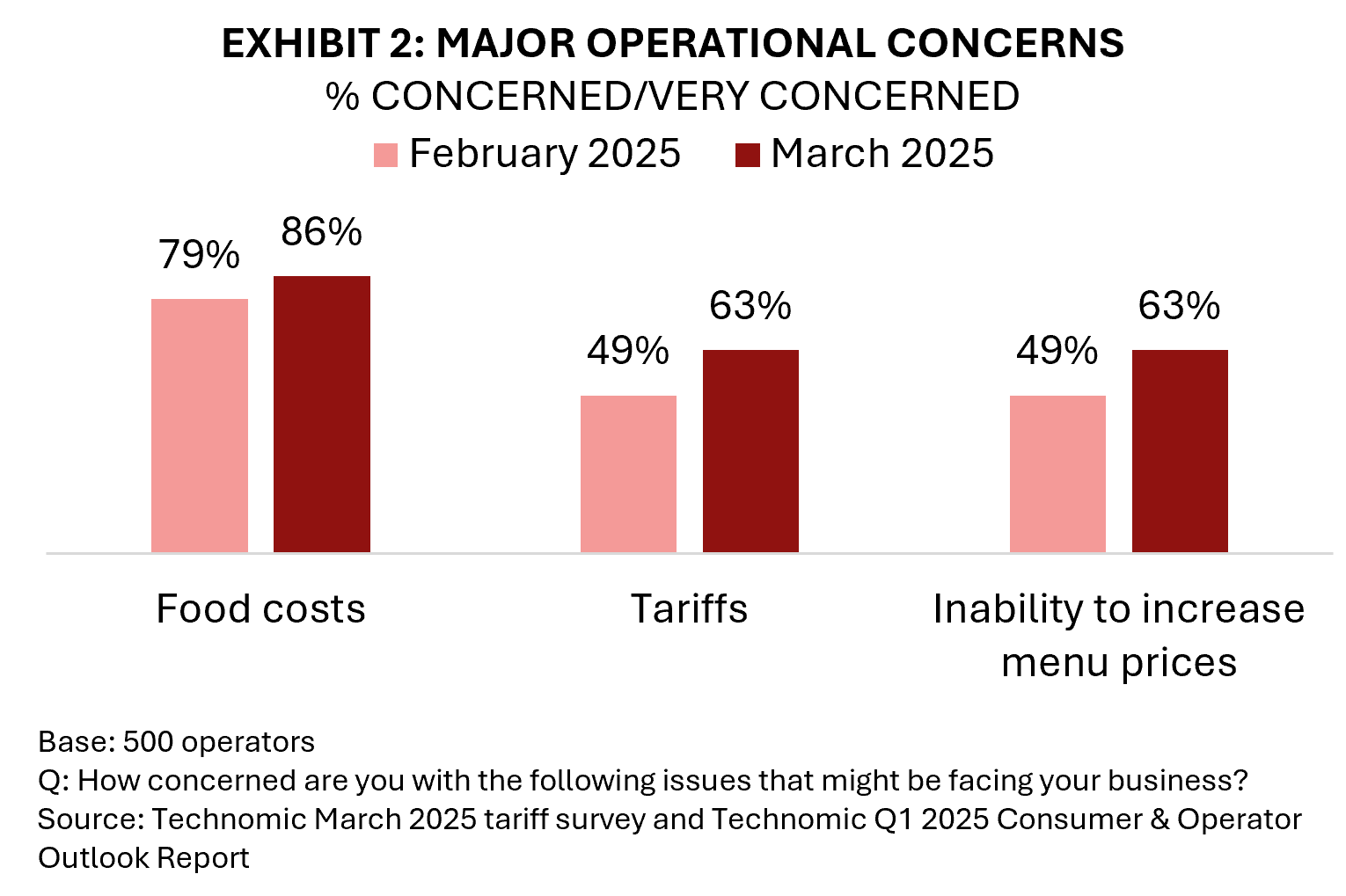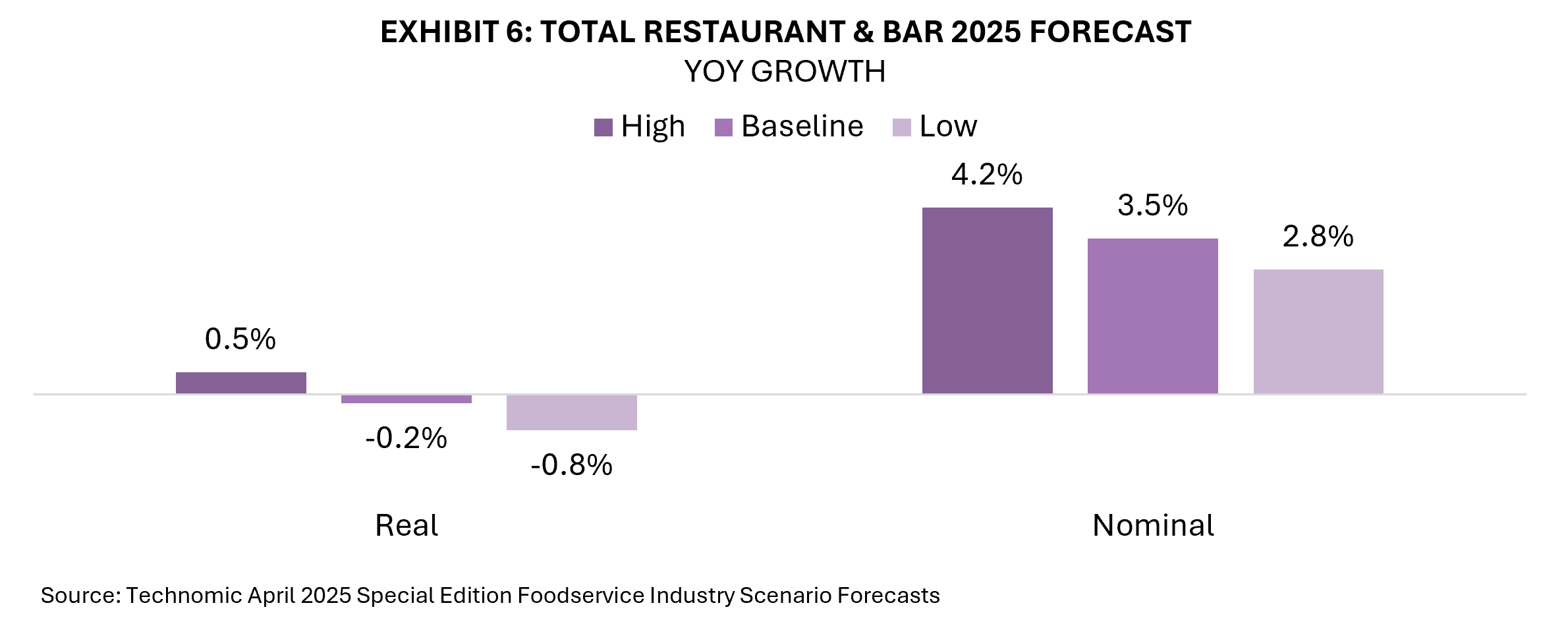ADVISORY BLOG—
Resilient Restaurants: Navigating Tariff Uncertainty with Operator Confidence
Considerable uncertainty has entered the market with the introduction and partial 90-day pause of tariffs, as well as shifting narratives surrounding these actions. To understand how these tariffs are impacting foodservice, Technomic conducted a study with operator decision-makers to learn more about how they were managing the situation. This whitepaper will share the results of the operator study, as well as a reintroduction of top-line, scenario-based forecasting.
From Subject Matter Expert, Rich Shank, Senior Principal and VP of Innovation
It’s important to note that the current state of tariffs, after the pause of the April 2 tariff announcement, still raises the average effective tariff rate by 30%. With that in mind, our forecast scenarios are designed to provide guidance around multiple possible outcomes given the tentative status of most tariffs.
The Bureau of Economic Analysis estimates that exports grew in 2024 by 3.9% and imports grew by 6.5%. For historical perspective, the growth rates of imports and exports during the pre- and post-pandemic period can be found in Exhibit 1. Trade deficits are at the heart of the current administration’s argument to support its tariff policy. However, data shows that the long-term trend of growing trade deficits has slowed, and this slower trade deficit growth is coupled with faster growth in both imports and exports, particularly for services.
This recent trend of an improving trade deficit changed significantly at the start of this year. A large spike in the trade deficit has occurred as buyers in the market stockpile in preparation for higher costs ahead. In the six months prior to the election (November 2024), the trade imbalance grew on average by 1% each month. However, since the election, the trade imbalance increased by 34% in December, 79% in January and 69% in February. This is likely a momentary increase due to stockpiling behaviors but is something to continue to watch given continued back-and-forth tariff conversations.


Tariff and Food Cost Concerns
We asked operators in February how concerned they were with tariffs along with a host of other looming challenges, followed by a deeper dive into the subject in March. The March survey came out of the field just one week before the April announcement of unexpectedly large tariffs across the globe, as well as the reannouncement of a 90-day pause.
We found that concerns about tariffs have increased significantly, even before the twin announcements, as has the already elevated concerns around rising food costs (See Exhibit 2). Couple this rise in concern with elevated feelings among operators that they don’t have the ability to raise their current prices, and you get an operator likely looking at other options to counterbalance potential cost increases.
On the surface, you might ask whether operators are losing confidence in their ability to navigate the market. The answer is, not yet. Why the confidence? We know that customers have heightened price-sensitivity, and our traffic patterns are showing it. Last year was the first instance of negative traffic growth since 2019 (down 0.8% vs. a decrease of 0.1%, respectively) and the start to this year has been slower than that (declining by 4.9% in February). When you look at this, you might assume operator confidence must be low right now. Up to February, this has not been the case.
Our operator confidence monitor examines operating sentiment for the current state of the business as well as future expectations. Both metrics currently sit at comparatively high points in the history of the monitor (See Exhibit 3).

This confidence does not mean there has yet to be an impact on operator purchases. In fact, 70% of operators report their food ingredient purchases have already been impacted at least modestly by tariffs. Disposables (61%), equipment (64%), beverages (48%) and uniforms (40%) have also already been impacted, but to a smaller extent (See Exhibit 4). In the face of these reported impacts, operators have been proactively making changes to their operations to prepare formore headwinds.
These preparations have operators feeling confident that they can weather a challenging market, at present. The top actions taken thus far have been to swap ingredients for a more local source (40%), raise prices (31%), examine each SKU for tariff-related price changes (28%), stockpile key purchases (20%) and make service changes (25%). See Exhibit 5 for the full list of actions taken.


Operator confidence stems from having previously navigated choppier waters. Historically, the restaurant market does not see the same level of decline as other markets during market downturns due to the need to eat, refresh and provide distractions for ourselves. Entertainment, experience and the need for good food will be as important as ever. But this confidence also comes from the preplanning actions that have been taken. Among those who have made changes to their operation already, 74% are saying they are confident those actions will enable them to successfully manage potential tariff impacts. The nimbleness that operators showed during COVID-19 has already appeared in the market and keeps them confident despite the challenges. Because this survey was launched just before the latest announcements, our April and May confidence numbers will tell us the sustainability of these confidence levels.
2025 Forecast Updates
We previously mentioned that Technomic moved back to a scenario-based forecasting model, and Exhibit 6 shows the top-line forecast for the year. A more complete forecast for each industry subsegment is available to subscribers of Technomic’s Long-Term Forecast.The tariff situation certainly altered our forecast for the year due to the projected drag on GDP growth and impact on inflation. Below is a brief description of each forecasting scenario to provide context.
The High Scenario
This assumes that trade negotiations are successful and mutually beneficial to trade partners with the outcome being a return to baseline trading relationships.
The Baseline Scenario
This assumes tariff negotiations result in increases, but not as much as is currently being implemented. In this scenario, we see current forecasts for U.S. GDP being downgraded by 0.3% to 0.4%.
The Low Scenario
This is the worst-case scenario and most closely aligned with a reimplantation of the largest tariff plan announced on April 2. It assumes a full-scale trade war. In this instance, we expect U.S. GDP forecasts to be downgraded by 1.0% to 1.2% for the year in 2025. The broader impact will spill beyond middle- to low-income consumers as price inflation returns significantly under this scenario, market capital becomes constrained and a recession ensues.

Recommended Actions
We expect the actions listed in Exhibit 5 to increase over the coming months. Operators, suppliers and purchasing partners (e.g., distributors, GPOs, etc.) should be working together to identify key areas of impact and build plans to mitigate risk, focusing on ingredient shifts that will preserve quality and limit cost increases passed on to consumers. This may not mean tariff avoidance at all. It may mean finding the cheapest alternate route to the plate. We entered the year concerned about consumer pricing exhaustion, and escalating price increases at this time, like in 2022 and 2023, will have a large, negative impact on traffic and create added risks to the business many operators cannot afford. With that in mind, here are key actions to consider if you are not already doing so for your own business or your operator customers.
1. Study the Harmonized Tariff Schedule and compare your ingredient sourcing. It gets updated as tariffs get implemented. This schedule will provide a guide to help target your ingredient purchases that are impacted and their level of cost increase.
2. Work with supplier and purchasing partners to identify ingredient swaps that match your specifications. Understand the provenance of your purchases and map them to the tariff schedule, as well as their potential alternatives.
3. Take price increases in stages, if possible, to soften the traffic blow. If you can, target a maximum of 2.5% change. Price increases are inevitable, but going beyond 2.5% for the year will introduce significant risks.
4. If that is not possible, find new higher value innovations that can justify a higher price point. A truly incremental growth item will help subsidize possible changes in margin on problem products where price-sensitivity is too high to adjust.
5. In addition to finding items, platforms or ingredients that will drive excitement and create incremental reasons to spend, build an everyday value proposition that rewards loyalty and frequency. This may require experimentation and consistent refreshment of existing value plays. Innovation is crucial in tight market conditions and experimenting with new everyday value options, alongside premium innovations, will provide balance to your customer acquisition strategy.
6. Monitor shifts in the tariff environment and adjust strategies related to the above accordingly. Here is a tariff-tracking resource that updates tariff levels per country, as well as a timeline of when specific tariff actions have been or will be implemented.
NEVER MISS AN UPDATE
Subscribe to Our Emails
Unique content, conversation and thought leadership from Technomic is just a click away.
















